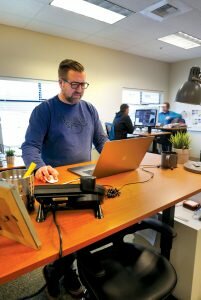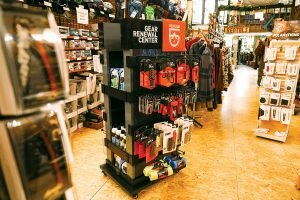 Tenacious Tape, now available in animal shapes, is one of Gear Aid's best known products. Photo courtesy of Gear Aid.
Tenacious Tape, now available in animal shapes, is one of Gear Aid's best known products. Photo courtesy of Gear Aid.For people who use Gear Aid products, Pat Kennedy’s first experience with the company may sound familiar. The first time he wore his $300 Mountain Hardwear puffy coat – the first nice puffy coat he ever owned – his dog jumped on him and tore a one-inch rip in the synthetic fabric.
Kennedy, an REI employee, patched it with some repair tape he’d received as a sample.
That was 10 years ago. “I still have that jacket,” he said. “It’s falling apart in so many ways. That one patch is probably the strongest part of the whole jacket.” Now Kennedy keeps that same stuff – Gear Aid’s Tenacious Tape – stashed in all his backpacks, the junk drawer and his glove box. In the decade since, he’s used products across Gear Aid’s line, which includes everything from cleaning products and wash-in waterproofer for technical gear to camping accessories and wetsuit repair adhesive.
As a market coordinator at the Bellingham REI store, Kennedy has also seen Gear Aid, formerly known as McNett Corporation, become more familiar to shoppers.
“Customers are definitely more aware of Gear Aid now. We have Gear Aid stuff parked right in the front of the store in the winter. Because of the amount of tears you see in puffy jackets and ski jackets, it’s probably one of our best selling $10 items,” he said.
If the company has become more familiar to customers in the last 10 years, it’s for good reason. The Bellingham-based company of about 45 employees has gone through some big changes recently: a legal name change, original owners selling the company in 2015, and hiring former vice president of operations at Outdoor Research, Clark Campbell, as president.
For customers, the biggest change is its rebrand – all the various brands formerly under the McNett umbrella, including, Outgo, McNett Tactical, M Essentials, Aquaseal and Tenacious Tape, are now known as Gear Aid.
The company sells products in 80 countries and partners with brands like REI, Patagonia and hundreds of others; Patagonia sells Tenacious Tape in its own custom shapes (think salmon and buffalo) and its own packaging, while other companies include the repair tape or other Gear Aid goodies with their outerwear, for example. Despite its ubiquity, its products didn’t have as much name recognition before the rebrand. The rebrand caused a temporary drop in sales, but with that out of the way, Gear Aid is once again ready to grow.
Duane and Nancy McNett started the company in 1981 in New York. They originally imported and sold expensive rain gear for golfers. When they started getting requests for repair kits to fix the flexible rubber suits, they developed the precursor to Aquaseal, the company’s adhesive for repairing wetsuits, waders and other flexible water gear.
The rain gear company they imported from went out of business, so the McNetts changed course and developed more products around the Aquaseal formula. The McNetts dove into the world of scuba and from there discovered more and more channels for their products.
“It basically became the standard for flexible repairs for outdoor gear,” said Sean Fields,
 Sean Fields at Gear Aid headquarters. Photo by Oliver Lazenby.
Sean Fields at Gear Aid headquarters. Photo by Oliver Lazenby.current vice president of brand for Gear Aid. “Now the whole mentality of care and repair for outdoor gear and the broader umbrella started to come alive.” And as they entered new markets like hunting, boating and camping, it made sense to brand the products differently.
Fields joined the company in 2015, just before Nancy and Duane McNett retired and sold the company to Coghlan’s LTD, Winnipeg-based makers of the classic camping cook set and other camping and outdoor accessories.
That year, Field recommended the company rebrand itself, and the leadership agreed that it was time – customers were putting more emphasis on knowing the story and the history of brands. Gear Aid captures the company’s mission of caring for gear, so it was the logical choice to represent the whole line.
Though rebranding made long-term sense, it came with some short-term penalties. Products became temporarily less searchable online. New names confused customers. Retailers stopped placing orders when they heard about the rebrand because they wanted to wait for the new stuff.
“Now that we’ve gotten through that, we’re able to focus more. We’re no longer redoing packaging, we’re doing more brand pieces and engaging with our customers more and supporting our retailers,” Fields said. “We’re really starting to focus on how we grow.”
Gear Aid is situated in one of the bigger buildings in a business park along Whatcom Creek. A warehouse for shipping and some manufacturing is connected to a workshop-like space for product development and a sparse, open office with a couch and an acoustic guitar nearby.
A series of stories hangs on the wall, blueprints for a collection of videos about how customers use Gear Aid products. They aim to be part inspiration and part detail about how to make repairs or take care of gear. The company just produced a sturdy, pocket-sized field care guide with instructions for patching holes, repairing inflatables, fixing boots and more.
When the company had multiple brands, these projects might have cost four times as much, Fields said, and marketing one brand wouldn’t necessarily help its other brands; now, a hiker who has a good experience using Tenacious Tape might recognize the name when shopping for waterproofing products. “The rebrand makes sense from a resource standpoint, from a brand voice standpoint, from a consumer standpoint – for people to be able to just understand that all these products come from one company,” Fields said.
 A Gear Aid display at Backcountry Essentials. Photo courtesy of Gear Aid.
A Gear Aid display at Backcountry Essentials. Photo courtesy of Gear Aid.And for the most part, it’s working – people are recognizing the brand in a way they didn’t before, he said. “When people are starting to get stoked about your brand – specifically about your brand, not your company – that's the cool thing,” he said. “It starts to build that culture where it’s no longer this obscure company, it’s now a recognized brand in our community, in our industry and even globally.”
For Gear Aid, the timing seems right: people are more aware of waste than ever, and as gear gets more expensive, more people are trying to repair their gear, Kennedy said. Patagonia and other outdoor giants are spreading a message of repair and reuse, or at least marketing that way. More than ever, patches are a sign of a well-loved piece of gear with an adventurous life, rather than a mark of thrift.
“This coming year we’ll focus on telling more of our story, getting people engaged and educated about what we do and how to do it and really focusing on the DIYer that we all have in us,” Fields said. “Honestly, when people get stoked about how they’re able to repair something themselves, there’s an empowerment that happens.”